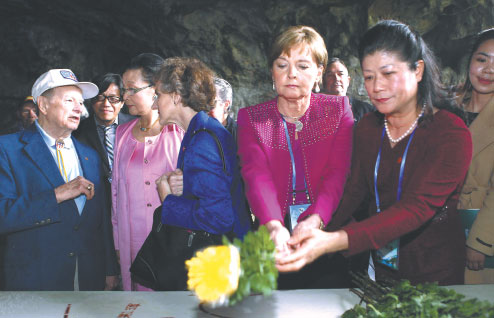Editor's note: This is the third in a series of special reports about the experiences of foreigners who either lived or served in China between 1937 and 1945.
The American Volunteer Group has legendary status in China, and the US pilots who flew as members of the Chinese air force have now been honored in the town that was their main center of operations, as Li Yang reports from Guilin, Guangxi Zhuang autonomous region.
 |
|
Nell Calloway (second from right), a granddaughter of Lieutenant General Claire Chennault, and Chen Lihua, deputy mayor of Guilin city, pay tribute to those who died in the fight against the Japanese invasion of China at a newly opened heritage park in Guilin in the Guangxi Zhuang autonomous region on March 28. [HUO YAN/CHINA DAILY] |
China has paid tribute to the 1st American Volunteer Group, better known as the Flying Tigers, a team of US pilots who assisted the fight against Japanese occupation during World War II, by opening a heritage park in Guilin in the Guangxi Zhuang autonomous region.
Vice-Premier Liu Yandong hosted the opening ceremony with Guangxi Party chief Peng Qinghua, and representatives from the United States.
The park - which covers an area of 17 hectares, and comprises a museum, a cave command post on a nearby mountain, barracks, hangars and flight strips - was funded by the Flying Tigers Historical Organization, a nonprofit group in Groveland, California. It was constructed on the site of the former Yangtang airport, which was built by the locals and the US volunteers in 1942 under extremely dangerous conditions.
Local villagers, governments and the FTHO have donated hundreds of relics related to the Flying Tigers to the museum, and Florence Lee Fang, the FTHO's honorary president, will donate a C-40 transport plane, the dominant model used by the US army air forces in the Pacific theater, which will soon go on permanent display.
Liu's presence at the ceremony demonstrated the significance China attaches to the Flying Tigers' legacy in the 70th anniversary year of the victory over the axis powers.
A global dream
Peace is not only a "China Dream", but also a dream of all peoples around the world, according to FTHO Chairman Major General James Whitehead. "The park is an important beginning to educate the people and their children about the history of a time when two peoples fought together for a common goal, and about the heroes."
Liu said: "Recalling the history of when the people of China and the US fought evil side by side is of great importance for the establishment of new type of big-power relationship between the two countries. I hope China and the US can increase exchanges and cooperation, continue interpersonal friendships, and make a larger contribution to world peace."
Peng hopes Guilin can continue to expand construction of the park and "make it an important window to foster mutual understanding between Guangxi and the US, and to deepen bilateral cooperation in economics, trade, culture and tourism".
The Flying Tigers squadrons, led by Lieutenant General Claire Chennault, were set up in Rangoon, Myanmar, in 1941 to resist the Japanese invasion of Asia, and to safeguard the air transport route, known as the "Hump course", which connected Southwest China with the rest of South Asia.
In June 1942, Chennault arrived in Guilin with dozens of P-40 Warhawk fighter planes and built three military airports in the city, which stood on the front line with the Japanese army.
Chennault trained, organized and inspired his pilots. He taught them to fight in pairs; to use speed and diving power to make a pass, shoot, and break away. With the success of the early warning net that Chennault had devised, the American Volunteer Group destroyed almost 300 enemy aircraft, while only losing 12 of their own in just six months.
On July 4, 1942, the group was disbanded, and replaced by the 23rd Fighter Group of the United States Army Air Forces, which was itself later absorbed into the US 14th Air Force with Chennault as commander.
In the two or so years that followed, the 14th Air Force destroyed more than 2,600 enemy aircraft, sank or damaged 2,230,000 metric tons of enemy merchant ships, and 45 navy vessels, and killed more than 66,700 enemy troops in South China - a remarkable achievement for the smallest and most remote air force of WWII.
Chennault, who withdrew from Guilin with his pilots in October 1944, ended his memoir Way of a Fighter with these words: "It is my fondest hope that the sign of the Flying Tiger will remain aloft just as long as it is needed and that it will always be remembered on both shores of the Pacific as the symbol of two great peoples working toward a common goal in war and peace."
At the ceremony, Nell Calloway, Chennault's granddaughter and director of the Chennault Aviation and Military Museum in Monroe, Louisiana, said: "We come together under the sign of the Flying Tigers, and my grandfather's words hold as much importance now in 2015 as they did in 1949 (when Chennault's book was published). And we must work together toward our common goals: Prosperity, stability, respect and understanding."
Since 1983, hundreds of Flying Tiger pilots and their relatives have visited the site of the former airport at Yangtang and spoken with the local villagers, hundreds of whose ancestors died during the construction of the facility, either while working in the quarry or during aerial bombardments by the Japanese air force.
